Like so many other technology solutions in the customer contact arena, self-service started off as supporting a cost reduction strategy, and while this benefit is still very much part of the self-service tool box, there is now a growing emphasis placed upon gathering information about these interactions to feed into voice of the customer programmes, improving the customer experience and optimising the knowledge base.
As with most successful business implementations, self-service is seen as win-win for both the organisation and the customer.
The three main drivers for self-service considered in this section are:
- Increased profitability: through avoiding unnecessary live contacts and increasing cross-selling and upselling
- Improved performance: through easing pressure on agents, performance metrics such as speed to answer and call abandonment rates are improved, along with customer experience
- Meeting customer demand: many modern customers wish to do business outside typical office hours, and are confident about using self-service. Having 24/7 availability on this channel means that customers can solve many issues how and when they wish, without the business having the expense of fully staffing a contact centre all day. Customers also value having a choice of channels depending on what they are trying to do: sometimes speed is of the essence, but at other times only a human interaction will do.
Download the report to learn more.
